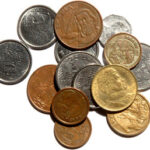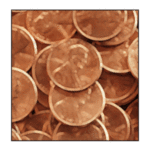The Sacagawea Dollar coin is one of those coins that consumers shy away from spending. There are a lot of reasons for that and the most valid reason is because they really are just too heavy and cumbersome to even think about having them in our pocket or purse. Afterall, what is more convenient at the fast food drive through, 5 coins or a $5 bill?
For the collector, these are great coins! They are very easily obtainable, they are attractive and will start anybody on a path to coin appreciation. I know that for younger collectors just starting out, it’s very exciting to receive a “gold coin” for their collection. These can be had for face value right from your bank by the single coin or by the roll.
The Sacagawea Golden Dollar coins debuted in January 2000. The new dollar coin replaced the very unpopular Susan B. Anthony (SBA) dollar coin, which had circulated since 1979. Because demand had increased for a dollar coin in commerce, the government’s supply of SBA dollars was nearly exhausted, creating a need for a new dollar coin that would be easily distinguishable from other change.
The United States Dollar Coin Act of 1997 required the Treasury Department to place into circulation a new dollar coin similar in size to the Susan B. Anthony dollar coin, golden in color with a distinctive edge. The law required the Treasury Secretary, in consultation with Congress, to select the designs for both sides of the new coin, although the design on the tails (reverse) side is required under the statute to depict an eagle.
Sacagawea was the Shoshone Indian who assisted the historic Lewis and Clark expedition. Between 1804-1806, while still a teenager, she guided the adventurers from the Northern Great Plains to the Pacific Ocean and back. Her husband, Toussaint Charbonneau, and their son who was born during the trip, Jean Baptiste, also accompanied the group.
Without Sacagawea’s navigational, diplomatic, and translating skills, the famous Lewis and Clark expedition would have perished. For one, she helped Lewis and Clark obtain the horses they needed to continue their journey.
The obverse (front) was designed by Artist Glenna Goodacre who used a 22-year-old Shoshone woman named Randy’L He-dow Teton as the model for the young Sacagawea. The reverse side was designed by Thomas D. Rogers.
Sacagawea dollars were given a smooth outside edge (similar to the Nickel) and gold color so it is not confused with a quarter as the Susan B. Anthony dollar was. This makes it the only gold-colored coin in the United States that is currently circulating. Despite a major promotional blitz by the United States government, these coins failed to gain popularity with the public.
Even though these are rarely used in every day transactions and are considered currency, these are much more suitable for collecting. As stated earlier in this article, they can be had for face value at your bank. For the more serious collector, mint sets and proof sets can be purchased at the US Mint. San Francisco mint marks for these coins are only available in proof sets.
The U.S. has been issuing dollar coins since 1794 and will probably continue to do so as long as people continue to carry and use “physical” money. On April 7, 2000, the General Accounting Office reported that replacing all paper $1 bills with dollar coins would save taxpayers $522.2 million per year. A circulating coin, says the GAO, last about 30 years, compared to the average 17 month lifetime of a paper dollar. However, until dollar demonination coins become more acceptable by the public, these beauties that we know as the Sacagawea dollar are best kept in the collections.
- Edge: plain
- Weight: 8.1 g
- Diameter: 26.5 mm
- Composition: 88.5% Copper, 6% Zinc, 3.5% Manganese, 2% Nickel





